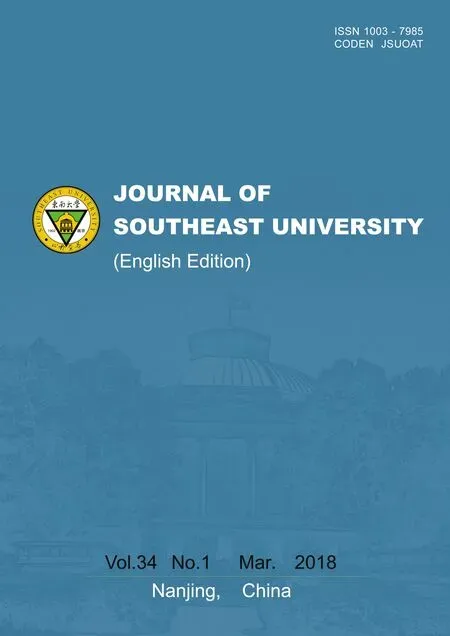Generalized Cayley-Hamilton theoremfor core-EP inverse matrix and DMP inverse matrix
2018-04-12WangHongxingChenJianlongYanGuanjie
Wang Hongxing Chen Jianlong Yan Guanjie
(1School of Mathematics, Southeast University, Nanjing 211189, China)(2School of Science, Guangxi University for Nationalities, Nanning 530006, China)
In this paper, we use the following notations.The symbolCm,nis the set ofm×nmatrices with complex entries, and rk(A)represents the rank ofA∈Cm,n.LetA∈Cn,n, and then the smallest non-negative integerk, which satisfies rk(Ak+1)=rk(Ak), is called the index ofAand is denoted as Ind(A).The Moore-Penrose inverse ofA∈Cm,nis defined as the unique matrixX∈Cn,msatisfying the equationsAXA=A,XAX=X, (AX)*=AX, (XA)*=XA, and is denoted asX=A+.The Drazin inverse ofA∈Cn,nis defined as the unique matrixX∈Cn,nsatisfying the equationsXAk+1=Ak,XAX=X,AX=XAand is usually denoted asX=AD(see Ref.[1]).The core-EP inverse ofA∈Cn,nis defined as the unique matrixX∈Cn,nsatisfying the equationsXAk+1=Ak,XAX=Xand (AX)*=AX, and is denoted asX=A⨁[2].The DMP inverse ofA∈Cn,nis defined as the unique matrixX∈Cn,nsatisfying the equationsXAX=X,XA=ADAandAmX=AkA+, and is denoted asX=Ad,+[3].More details of the Drazin, core-EP, DMP inverses can be seen in Refs.[4-8].
The Cayley-Hamilton theorem has many applications in nonlinear time-varying systems, electric circuits, etc.The classical Cayley-Hamilton theorem was extended to the fractional continuous-time and discrete-time linear systems[9], nonlinear time-varying systems with square and rectangular systems[10], the Drazin inverse matrix and standard inverse matrix[11], etc.More details about the Cayley-Hamilton theorem and its applications can be read in Refs.[9-13].Therefore, it is very interesting to investigate the Cayley-Hamilton theorem for the core-EP inverse matrix and DMP inverse matrix.In this paper, our main tools are core-EP decomposition and generalized inverses.
1 Preliminaries
In this section, we present some preliminary results.
Theorem1[14, Cayley-Hamilton theorem]LetpA(s)=det(sEn-A)be the characteristic polynomial ofX∈Cn,n.ThenpA(A)=0.
Theorem2[14]LetA∈Cn,nis singular, i.e.det(A)=0, and the characteristic polynomial ofAbe
pA(s)=det(sEn-A)=sn+an-1sn-1+…+a1s
(1)
Then
fA(AD)=a1(AD)n+a2(AD)n-1+…+an-1(AD)2+AD=0
(2)

(3)


(4)
whereT∈Crk(A),rk(A)is non-singular,Nis nilpotent andNk=0.
Lemma3Let the core-EP decomposition ofA∈Cn,nbe as in Lemma 2.Then the core-EP inverse ofAis
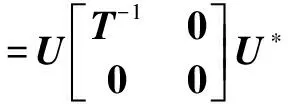
(5)
Let the core-EP decomposition ofAbe as in (4).Then
(6)
and

(7)
2 Main Results
In this section the classical Cayley-Hamilton theorem will be extended to the core-EP inverse matrix and DMP inverse matrix.By assumption, matrixAis singular, i.e.det(A)=0.
Lemma4Let the characteristic polynomial ofA∈Cn,nbe as in Eq.(1).Then
fA(A⨁)=a1(A⨁)n+a2(A⨁)n-1+…+
an-1(A⨁)2+A⨁=0
(8)
ProofUsing (1)and Theorem 1 we obtain
An+an-1An-1+…+a1A=0
(9)
It follows from Lemma 2 and (6)that
(10)
Post-multiplying (10)by
we have
(11)
Therefore, by applying (7), we obtain (8).
Example1Let
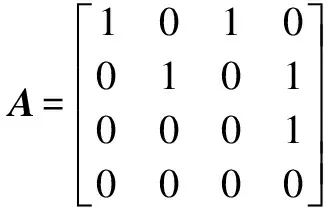
Then Ind (A)=2, the DrazinADis
and the core-EP inverseA⊕is
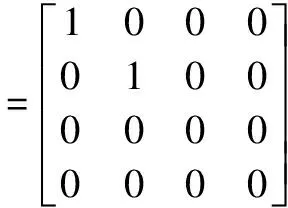
The characteristic polynomial ofAis

From the classical Cayley-Hamilton theorem, we haveA4-2A3+A2=0.By applying Lemma 4, we obtain (A⊕)3-2(A⊕)2+A⊕=0.
Note that, if the characteristic polynomials ofA⨁andADis
pA⨁(s)=det(sEn-A⨁)=sn+bn-1sn-1+…+b1s
(12)
pAD(s)=det(sEn-AD)=sn+cn-1sn-1+…+c1s
(13)
respectively, we cannot obtain
pA⨁(s)=b1An+b2An-1+…+bn-1A2+A
(14)
pAD(s)=c1An+c2An-1+…+cn-1A2+A
(15)
Example2Let
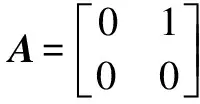
It is easy to confirm that the core-EP inverseA⊕is
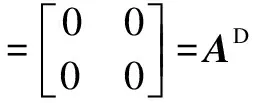
Then
but
fAD(s)=fA⊕(s)=0A2+A=A≠0
Theorem3LetA∈Cn,nand Ind(A)=k.Then the characteristic polynomial ofA⨁∈Cn,nis
pA⨁(s)=sn+bn-1sn-1+…+bn-rk(Ak)sn-rk(Ak)
(16)
Furthermore,
bn-rk(Ak)An+…+bn-1An-rk(Ak)+1+An-rk(Ak)=0
(17)
ProofLet the core-EP decomposition ofA, i.e.A=A1+A2, be as in Lemma 2.Then
sn-rk(Ak)det(sErk(Ak)-T-1)
Therefore, we obtain (16).Using (16)and Theorem 1, we obtain
(A⨁)n+bn-1(A⨁)n-1+…+bn-rk(Ak)(A⨁)n-rk(Ak)=0
(18)
that is,
(19)
Post-multiplying (19)by
we have (17).
Theorem4LetA∈Cn,n, Ind(A)≤1 and the characteristic polynomial ofA⨁∈Cn,nbe as in (12).Then
fA⨁(A)=b1An+b2An-1+…+bn-1A2+A=0
(20)
Theorem5LetA∈Cn,nand Ind(A)=k.Then the characteristic polynomial ofAD∈Cn,nis
pAD(s)=det(sEn-AD)=sn+cn-1sn-1+…+cn-rk(Ak)sn-rk(Ak)
(21)
Furthermore,
cn-rk(Ak)An+…+cn-1An-rk(Ak)+1+An-rk(Ak)=0
(22)

sn-rk(Ak)det(sErk(Ak)-Σ-1)
Therefore, we obtain (21).Using (21)and Theorem 1 we obtain
(AD)n+bn-1(AD)n-1+…+bn-rk(Ak)(AD)n-rk(Ak)=0
that is,
Post-multiplying the above equation by
Therefore, we obtain (22).
Theorem6LetA∈Cn,nand Ind(A)≤1 and the characteristic polynomial ofAD∈Cn,nbe as in (13).Then
fAD(A)=c1An+c2An-1+…+cn-1A2+A=0
(23)
LetA∈Cn,nand Ind(A)=k.Then the DMP inverse ofAisAd,+=ADAA+[3].Since (Ad,+)2=ADAA+ADAA+=ADAA+AADA+=(AD)2AA+, we obtain
(Ad,+)p=(AD)pAA+
(24)
wherepis a positive integer.
Theorem7Let the characteristic polynomial ofA∈Cn,nbe as in (1).Then
fA(Ad,+)=a1(Ad,+)n+a2(Ad,+)n-1+…+
an-1(Ad,+)2+Ad,+=0
(25)
ProofBy applying (1)and Theorem 2, we obtain
a1(AD)nAA++a2(AD)n-1AA++…+
an-1(AD)2AA++ADAA+=0
From (24), we can obtain (25).
[1]Ben-Israel A, Greville T N E.Generalizedinverses:Theoryandapplications[M].2nd ed.Berlin: Springer, 2003: 163-168.
[2]Manjunatha Prasad K, Mohana K S.Core-EP inverse[J].LinearandMultilinearAlgebra, 2014,62(6): 792-802.DOI:10.1080/03081087.2013.791690.
[3]Malik S B, Thome N.On a new generalized inverse for matrices of an arbitrary index[J].AppliedMathematicsandComputation, 2014,226: 575-580.DOI:10.1016/j.amc.2013.10.060.
[4]Gao Y, Chen J, Ke Y.*-DMP elements in *-semigroups and *-rings[J].arXivpreprint.arXiv: 1701.00621, 2017.
[5]Li T, Chen J.Characterizations of core and dual core inverses in rings with involution[J].LinearandMultilinearAlgebra, 2017: 1-14.DOI: 10.1080/03081087.2017.1320963.
[6]Wang H.Core-EP decomposition and its applications[J].LinearAlgebraandItsApplications, 2016,508: 289-300.DOI:10.1016/j.laa.2016.08.008.
[7]Zou H, Chen J, Patrìcio P.Characterizations ofm-EP elements in rings[J].LinearandMultilinearAlgebra, 2017: 1-13.DOI: 10.1080/03081087.2017.1347136.
[8]Prasad K M, Mohana K S.Core-EP inverse[J].LinearandMultilinearAlgebra, 2014,62(6): 792-802.DOI:10.1080/03081087.2013.791690.
[9]Kaczorek T.Cayley-Hamilton theorem for fractional linear systems[C]//8thConferenceonNon-IntegerOrderCalculusandItsApplications.Zakopane, Poland, 2017: 45-56.DOI:10.1007/978-3-319-45474-0_5.
[10]Kaczorek T.An extension of the Cayley-Hamilton theorem for nonlinear time-varying systems[J].InternationalJournalofAppliedMathematicsandComputerScience, 2006,16: 141-145.
[11]Kaczorek T.Cayley-Hamilton theorem for Drazin inverse matrix and standard inverse matrices[J].BulletinofthePolishAcademyofSciencesTechnicalSciences, 2016,64(4): 793-797.DOI:10.1515/bpasts-2016-0088.
[12]Feng L G, Tan H J, Zhao K M.A generalized Cayley-Hamilton theorem[J].LinearAlgebraandItsApplications, 2012,436(7): 2440-2445.DOI:10.1016/j.laa.2011.12.015.
[13]Hwang S G.A generalized Cayley-Hamilton theorem for polynomials with matrix coefficients[J].LinearAlgebraandItsApplications, 2011,434(2): 475-479.DOI:10.1016/j.laa.2010.08.039.
[14]Horn R A, Johnson C R.Matrixanalysis[M].Cambridge,UK: Cambridge University Press, 2012: 109-111.
[15]Wang H, Liu X.Partial orders based on core-nilpotent decomposition[J].LinearAlgebraanditsApplications, 2016,488: 235-248.DOI:10.1016/j.laa.2015.09.046.
杂志排行
Journal of Southeast University(English Edition)的其它文章
- Effects of superabsorbent polymer particles on flexural properties and self-healing behavior of ECC
- Effects of flat and elongated aggregateson the performance of porous asphalt mixture
- Durability related environmental zonation and design methodology for marine RC structures
- Influence of longitudinal slope on the mechanical response of steel deck pavement
- Scheduling optimization problem considering time-of-use tariffs and piece-rate machine maintenance in EAF steelmaking
- Modeling and analysis of cloud computing system survivability based on Bio-PEPA
